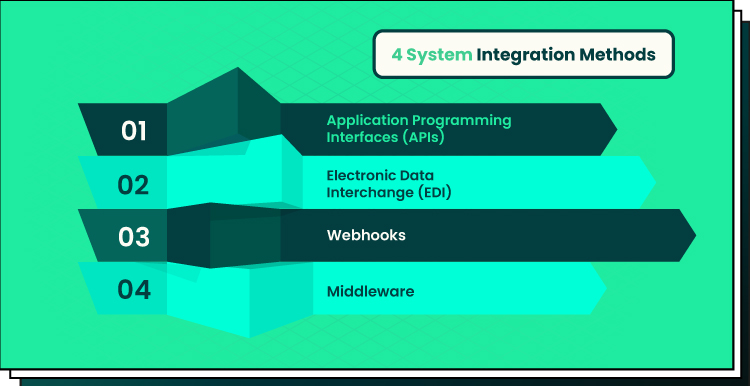Are you looking for a way to make your business run more smoothly? System integration could be the answer. It’s an effective way to connect different systems and processes to work together in harmony.
Let’s dig into more details.
System Integration Definition
System integration is the process of linking up different applications and software, making them work together in one efficient system. This could include using an integrated customer relationship management platform that ties into your online store or a payment gateway connected to accounting software.
By integrating all these systems, companies can achieve streamlined processes and greater efficiency. All the data from different sources will be centralized, giving real-time access to information about business operations. It will also give a better overview of customer activity and help make informed decisions quickly.
Businesses might integrate their systems to streamline operations, save time and money, or better meet customer needs. Integrating systems can also help make it easier to track data, analyze results, and identify trends. System integration combines different software and hardware components into a single system that can work together. This makes it easier for businesses to manage data, share information across departments, automate processes, and improve overall efficiency.
System Integration Types
Different system integration types allow for different possibilities. Below are the most common types of system integration and the unique advantages they offer.

Enterprise Application Integration
EAI allows businesses to integrate their applications and data sources into one unified system. This helps reduce time spent manually moving data between different systems and can help improve customer service. EAI allows different applications to communicate and share data with each other, helping organizations streamline their processes, reduce costs, and increase efficiency.
EAI can be used for many different types of systems, such as customer relationship management (CRM), enterprise resource planning (ERP), supply chain management (SCM), and more. EAI makes it easier for employees to access the data they need quickly and accurately.
Third-Party System Integration
Third-party system integration is the process of connecting two or more systems together to share data and information. If one system requires a certain format for its output, then the other system must be able to provide this exact format to integrate successfully. Any changes made to either system should not affect the output of the other.
Business-to-Business Integration
B2B integration is the process of connecting two or more businesses to share data and information. B2B integration can be used for various purposes, including order processing, inventory management, financial transactions, and customer relationship management.
B2B integration requires careful planning and implementation to ensure that all systems are connected properly and securely. Companies must also consider how they will manage the data being shared between them. It’s essential to have clear rules and guidelines in place so that both parties understand what is expected from each other.
Web Services Integration
Web services integration is connecting two or more applications over a network. This allows companies to create custom solutions tailored specifically to their needs. It can be used for tasks such as synchronizing data between different databases, creating API connections, and automating processes.
When setting up web services integration, it’s important to consider security measures and authentication protocols. Additionally, it’s essential to ensure that any changes made to each system will not affect the output of the other. By following the rules set forth by both parties, organizations can use web services integration to maximize efficiency and productivity.
Legacy System Integration
Integrating legacy systems into modern technology can be a daunting task. But, with the right approach and understanding of the benefits, it can be an incredibly rewarding experience. Legacy system integration means application modernization: taking existing systems and making them work together to create something new and improved.
The most apparent benefit of integrating legacy systems is that it allows businesses to take advantage of the latest technologies without starting from scratch. By connecting different systems, companies can save time and money by avoiding costly upgrades or replacements. They can also reduce their risk of data loss due to outdated hardware or software.
Another critical benefit of legacy system integration is increased efficiency. By combining multiple systems, businesses can streamline processes and automate tasks that take a lot of time or other resources.
System Integration Methods

Connecting systems can be done in different ways. Many options are available, from middleware and APIs to webhooks and EDI. Each one offers unique advantages, so it’s essential to evaluate your needs carefully before deciding which option is suitable.
Application Programming Interfaces (APIs)
API integration uses Application Programming Interfaces to link two or more systems together so they can communicate with each other. API integration is great for automating tasks but requires a technical understanding of programming languages. APIs provide the most common and straightforward way to connect two systems. An API call is made when an application requests information from another application, and it returns that information in a structured format.
APIs offer several advantages, such as increased speed of integration, more reliable data accuracy, and better scalability. They also save organizations money since they don’t require manual coding or physical connections between systems. However, APIs can be complex and require technical knowledge, so users should consider whether the advantages outweigh the disadvantages before using them.
Electronic Data Interchange (EDI)
EDI allows businesses to share data electronically in a standardized format, making it easier and faster for different companies to transact with each other. With EDI, information is quickly and accurately exchanged without requiring manual processes like faxing or mailing. By eliminating manual tasks, costs are reduced and accuracy is improved. Transactions can be completed much faster when using EDI instead of traditional methods.
A significant benefit of using EDI is its security. All communication is encrypted and authenticated, so you don’t have to worry about confidential data being compromised. And because all the parties involved in a transaction use standard formats and procedures, there’s no confusion about the data that’s being sent. As a result, transactions are more accurate, and less time is wasted trying to decipher the information. EDI also eliminates the need for paper documents, which saves resources, costs less money, and helps reduce environmental waste.
Webhooks
Webhooks provide a simpler way to connect systems compared to APIs. Webhooks use HTTP requests to communicate with other applications, allowing them to share information and react in real time when something changes. This makes it easier for data to be passed back and forth between different programs without requiring manual intervention.
With webhooks, businesses can quickly set up automated workflows that allow them to connect different applications and services. This eliminates the need to complete tedious tasks manually and provides streamlined processes that boost productivity and profitability. In addition, webhooks provide security for your data by ensuring that only authorized users can access certain information.
Middleware
Middleware can act as a bridge between two different programs, allowing them to communicate with one another efficiently. This makes it easier for data to be transferred from one system to another quickly and securely. Middleware also allows users to access multiple systems at once without having to log in separately each time. For example, if you need to access information from your accounting program and CRM, middleware can help make this happen more easily.
System Integration Approaches
Depending on the quantity and type of components that need to be connected, system integration can be approached using various architectural models.
Point-to-Point Model
This method involves connecting two systems directly without needing additional components or middleware. It’s an efficient way of integrating different systems and can be used in many scenarios.
A key benefit of this approach is that it allows data to flow quickly between two systems. A downside of this approach is that it can be difficult to update or modify your system if you need to make changes. This can become an issue as technology evolves, and systems may require tweaks or updates to continue functioning properly. In addition, the point-to-point model does not provide much flexibility; each system must be able to communicate directly with the other for it to work.
When to use it?
Point-to-point integration is suitable for organizations that need rapid data exchange between two or more systems. This model allows for direct communication between connected components, making it ideal for situations where speed is essential. For example, real-time analytics or financial transactions.
Hub-and-Spoke Model
This model allows for the centralization of data and processes, making it easier to manage and maintain your systems. It also helps reduce complexity by allowing you to focus on one core system that can be connected to other systems through “spokes” or connectors.
A hub-and-spoke model works by having a single source of truth at its center. All data flows into this central point, which distributes it to the various spokes. The spokes are responsible for connecting the different systems together and ensuring that all data is up-to-date and accurate. This makes it much easier to keep track of changes and updates
The hub-and-spoke model offers several advantages. First, it allows for the centralization of data and processes, making it easier to manage and maintain your systems. It reduces complexity by allowing you to focus on one core system that can be connected to other systems through “spokes” or connectors. Finally, it makes tracking changes and updates much simpler.
However, there are some drawbacks to this approach as well. Since all data is centralized in a single source of truth, it can become vulnerable to cyberattacks if not properly secured. Since all data must pass through the hub before being sent out to the spokes, it could lead to increased latency and slower performance.
When to use it?
This model can be especially useful for those with multiple applications or technologies that need to communicate, such as a customer database system and an analytics platform. By having everything connected through the hub, data can easily flow between components without extra effort.
Enterprise Service Bus (ESB) Model
An ESB is a software architecture that allows different applications and services to communicate with each other without having to make changes to their existing code. It acts as a bridge between two or more systems, allowing them to exchange data quickly and securely.
The ESB model makes system integration easier by providing a single access point for all communication. This means that instead of creating custom code for every connection, you only need to configure the ESB once. The ESB also provides additional features such as message routing, transformation, security, and logging.
One of the main benefits of using an ESB model is its flexibility. It can easily connect different systems, allowing for data exchange. This makes it easier to integrate new applications into existing ones without having to rewrite code or make major changes. Additionally, the ESB can also help with scalability by providing additional resources when needed.
On the downside, the ESB model can be expensive to implement and maintain. It also requires a significant amount of effort to configure the system for optimal performance properly.
When to use it?
The ESB model is best suited for projects with multiple systems that need to communicate with each other. It allows data to flow between applications without having to write custom code or manually configure connections. It simplifies complex integration management and keeps the system up-to-date as changes occur. The ESB model provides an abstraction layer that helps protect sensitive data from being exposed.
Integrated System Deployment Possibilities
The three most typical architectures have been outlined, although the truth is more nuanced than that. When referring to businesses that use various technologies, a single integration strategy may no longer be adequate. Employing various forms of middleware and API layers connecting IT components, businesses frequently need to blend all three approaches inside a single ecosystem. Fortunately, an increasing number of cloud platforms are providing their services to manage intricate integrations. Here are two popular deployment choices for you to consider.
Integration platform as a Service (iPaaS)
iPaaS is a cloud-based platform that enables businesses to integrate their applications, data, and processes. It provides an easy way for companies to connect different systems without building custom integrations from scratch. With iPaaS, organizations can quickly deploy integrated solutions with minimal effort and cost.
iPaaS offers several advantages over traditional integration methods. For example, it eliminates manual coding and allows users to configure connections between multiple systems easily. Additionally, iPaaS makes it easier to manage complex integrations by providing tools such as automated testing and monitoring. This helps ensure that all components of the system are working together properly.
Hybrid Integration Platform (HIP)
The HIP is a powerful tool for connecting different systems and applications. It allows businesses to quickly deploy integrated solutions without building them from scratch. HIPs are designed to be flexible, allowing users to customize their integrations with ease.
HIPs provide an output that can be used in many ways. For example, it can be used to create automated processes between two or more systems, such as sending data from one system to another. This type of automation helps streamline operations and reduce manual labor costs. HIPs can also be used to integrate existing systems into new ones, making it easier to keep up with changing technology trends.
Key Steps of System Integration

By integrating company data and technology, businesses may automate activities and achieve complete transparency. There are a few essential procedures to consider if you want to execute effective integration and quickly recoup your investments.
- Planning. Planning and feasibility analysis are key steps in the system integration process. This involves assessing the project’s goals, objectives, resources, and timeline to determine if it is feasible to complete the project as planned. It also includes analyzing potential risks and benefits associated with the project.
- Architecture modeling. This involves creating a system model that will be integrated, including its components and how they interact. This helps identify any potential issues or conflicts before the actual integration process begins.
- Implementation. This involves taking all the components and making them work together to achieve the desired outcome. During implementation, it’s important to ensure that the output meets the rules in the planning phase. This includes ensuring that the data is accurate, secure, and compliant with applicable regulations.
- Maintenance. This involves regularly checking the system for any issues, making sure all components are up-to-date and running smoothly, and troubleshooting any problems that arise.
Final Word
Whichever option you choose, system integration can help streamline your organization’s operations. In case you need help with this task, contact Forbytes. For more than 10 years, we help companies improve their business strategies and build world-class digital solutions.

Our Engineers
Can Help
Are you ready to discover all benefits of running a business in the digital era?

Our Engineers
Can Help
Are you ready to discover all benefits of running a business in the digital era?







